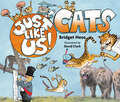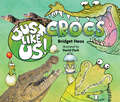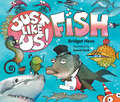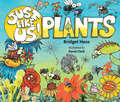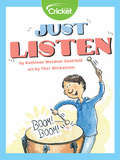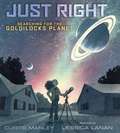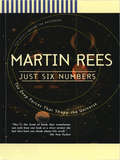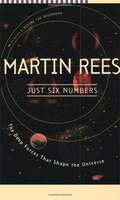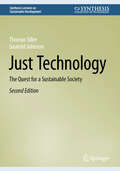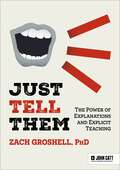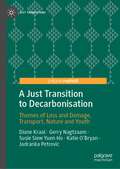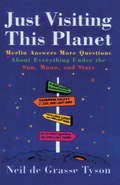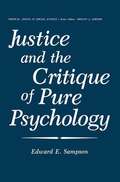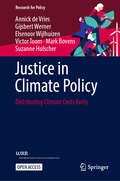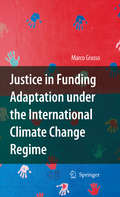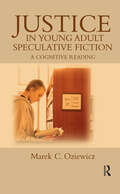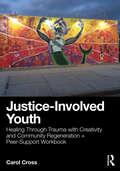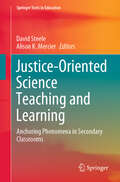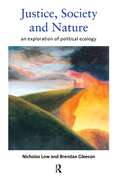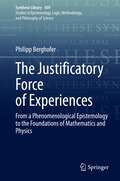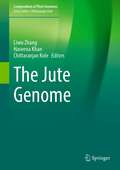- Table View
- List View
Just Like Us! Cats (Just Like Us!)
by Bridget HeosGet the facts on some of nature&’s most beloved animals and discover the unexpected ways humans and cats are similar in Just Like Us! Cats. Appealing mix of photographs and cartoon illustrations. What animals are loving parents, great diplomats, and world class CAThletes? CATS! While they may seem as different from us as animals can possibly be, we actually have a lot in common with our feline friends. From their hunting skills to their fondness for nap time, cats are a lot like us—though with fascinating twists all their own. Factual, funny, and featuring a dynamic mix of photographs and cartoon illustrations, Just Like Us! Cats will charm even the most reluctant nonfiction readers.
Just Like Us! Crocs (Just Like Us!)
by Bridget HeosGet the scoop on some of nature&’s most fearsome predators and discover the unexpected ways humans and crocodilians are similar in Just Like Us! Crocs. Appealing mix of photographs and cartoon illustrations. What animals love to bask in the sun, cool off with a quick swim, and don&’t always get along with their siblings? CROCS! While they might seem as different from us as animals can possibly be, we actually have a lot in common with our crocodilian comrades—alligators, crocodiles, muggers, caimans, and gharials. From tending to their young, to surfing a wave, crocodilians are a lot like us—though with fascinating twists all their own. Factual, funny, and featuring a dynamic mix of photographs and cartoon illustrations, Just Like Us! Crocs will charm even the most reluctant nonfiction readers.
Just Like Us! Fish (Just Like Us!)
by Bridget HeosGet the facts on an array of aquatic creatures and discover the unexpected ways humans and fish are similar in Just Like Us! Fish. Appealing mix of photographs and cartoon illustrations. What animal uses stilts, has roommates, finds safety in numbers, and even gets skin treatments at the spa? FISH! While they might seem as different from humans as animals can possibly be, we actually have a lot in common with our underwater neighbors. From hunting to homemaking to dressing to impress, fish are a lot like us—though with fascinating twists all their own. Factual, funny, and featuring a dynamic mix of photographs and cartoon illustrations, Just Like Us! Fish will charm even the most reluctant nonfiction readers.
Just Like Us! Plants (Just Like Us!)
by Bridget HeosGet the facts on an array of leafy organisms and discover the unexpected ways humans and plants are alike in Just Like Us! Plants. Appealing mix of photographs and cartoon illustrations. What living things wear perfume, bask in the sun, use weapons to defend themselves, and even go on ocean cruises? PLANTS! While they might seem as different from humans as possible, we actually have a lot in common with our photosynthesizing friends. From drinking water to disguising themselves to communicating with one another, plants are a lot like us—though with fascinating twists all their own. Factual, funny, and featuring a dynamic mix of photographs and cartoon illustrations, Just Like Us! Plants will charm even the most reluctant nonfiction readers.
Just Listen
by Kathleen Weidner ZoehfeldYou can't see them, but vibrations make waves in the air, and these waves reach your ears as sound.
Just Right: Searching for the Goldilocks Planet
by Curtis ManleyDo you wonder if humansare the only beings who wonderif they are alone in the universe?Our sun is a star.In the night sky are all kinds of stars,and orbiting those starsare planets like the ones in our own solar system.Could those planets have lifelike we do on Earth?Planet Earth is not too big,not too small, not too hot,and not too cold. It’s just right.Our very own Goldilocks planet . . . .Follow a young girlas she explores these questionsin this gorgeous book about the wondrous searchfor another Goldilocks planet.
Just Six Numbers: The Deep Forces That Shape The Universe
by Martin ReesThe genesis of the universe elegantly explained in a simple theory based on just six numbers by one of the world's most renowned astrophysicists
Just Six Numbers: The Deep Forces That Shape the Universe
by Martin ReesFrom Library Journal Science writer and astronomer Rees summarizes the history of the universe, pointing out that six numbers related to basic physical constants (for example, the relative strengths of the gravitational and electromagnetic attraction) determine how the universe developed. In addition, he shows how, if these numbers were only slightly different, stars and galaxies would not form, complex chemistry would not be possible, and life could not evolve. This raises the interesting philosophical question, Why? One could dismiss the question by saying that, if it were otherwise, we wouldn't be here to ask or that there is some underlying theory as yet unknown that would show that these values must be what they are. However, Rees suggests that these numbers were set shortly after the big bang and could well have been different. Indeed, there may be a multitude of other universes, forever inaccessible to us, in which they are different. Thus, with a huge choice of possible universes, one must exist that could support intelligent beings who can observe and question. Whether one agrees or not with Rees's ideas, his book is recommended for its cogent synopsis of modern cosmologic thought. [BOMC alternate selection.]--Harold D. Shane, Baruch Coll., CUN. ---Harold D. Shane, Baruch Coll., CUNY
Just Six Numbers (SCIENCE MASTERS)
by Sir Martin ReesAstronomer Royal Martin Rees shows how the behaviour and origins of the universe can be explained by just six numbers.How did a single genesis event create billions of galaxies, black holes, stars and planets? How did atoms assemble - here on Earth, and perhaps on other worlds - into living beings intricate enough to ponder their origins? This book describes the recent avalanche of discoveries about the universe's fundamental laws, and the deep connections that exist between stars and atoms - the cosmos and the microscopic world. Just six numbers, imprinted in the big bang, determine the essence of our world, and this book devotes one chapter to explaining each.
Just Six Numbers (SCIENCE MASTERS)
by Sir Martin ReesHow did a single genesis event create billions of galaxies, black holes, stars and planets? How did atoms assemble - here on Earth, and perhaps on other worlds - into living beings intricate enough to ponder their origins? This book describes the recent avalanche of discoveries about the universe's fundamental laws, and the deep connections that exist between stars and atoms - the cosmos and the microscopic world. Just six numbers, imprinted in the big bang, determine the essence of our world, and this book devotes one chapter to explaining each.(p) 1997 Orion Publishing Group
Just Technology: The Quest for a Sustainable Society (Synthesis Lectures on Sustainable Development)
by Thomas Siller Gearold JohnsonThe readers of the book Just Technology: The Quest for Cultural, Economic, Environmental, and Technical Sustainability, Second Edition of will benefit from its systematic approach in evaluating the true sustainability challenges facing society and will learn how to address these challenges in a just manner. Since the publication of the first edition of the book, the concept of a just society has become more important. Several new contemporary examples are now included to reinforce the concepts introduced in the previous edition. The book presents a framework to evaluate the appropriateness of technological approaches to address critical sustainable issues. The framework comprises four questions that aim to create more just approaches by broadening the context engineers consider when formulating solutions. Addressing the complexity of today's global challenges requires new ways of thinking. The idea that technology is always the best, maybe the only approach, needs to be reconsidered, and sustainable approaches must also draw from nontechnological areas.
Just Tell Them: The Power of Explanations and Explicit Teaching
by Zach GroshellThis book reaffirms the enduring importance of effective explanations at a time when "teacher talk" is often undervalued. Drawing on the science of learning, Zach Groshell explores essential techniques for showing, telling, demonstrating, modeling, and presenting so that even the most complex concepts become accessible to all learners.Engage with the art and science of "breaking it down" to discover how a direct and explicit approach to teaching can significantly impact classroom success.
Just Tell Them: The Power of Explanations and Explicit Teaching
by Zach GroshellThis book reaffirms the enduring importance of effective explanations at a time when "teacher talk" is often undervalued. Drawing on the science of learning, Zach Groshell explores essential techniques for showing, telling, demonstrating, modeling, and presenting so that even the most complex concepts become accessible to all learners.Engage with the art and science of "breaking it down" to discover how a direct and explicit approach to teaching can significantly impact classroom success.
A Just Transition to Decarbonisation: Themes of Loss and Damage, Transport, Nature and Youth (Just Transitions)
by Susie Siew Ho Diane Kraal Gerry Nagtzaam Katie O’Bryan Jadranka PetrovicThis book provides researchers and policy-makers with legal avenues to enable a just transition to decarbonisation. The focus is on the United Nations themes of loss and damage, transport, nature and youth - across Australia and other economies - to significantly reduce CO2 emissions by 2030 and beyond. The four themes scaffold discussions about a just transition beyond the UN Climate Change Conference COP28 in Dubai with the specific issues addressed in this book serving as a starting point for future discussions.
Just Visiting This Planet
by Neil De TysonIn a companion volume to Merlin's Tour of the Universe, here is a completely new collection of questions and answers about the cosmos for stargazers of all ages. Whether waxing about Earth and its environs, the Sun and its stellar siblings, the world of light, physical laws, or galaxies near and far, Merlin--a fictional visitor from Planet Omniscia--is easy to understand, often humorous, and always entertaining.Merlin fields a wide range of questions from many curious mortals, and in so doing draws on his own vast knowledge as well as the expertise of many close friends, including Archimedes, Galileo, Einstein, and Santa.So far, Merlin has not been stumped, responding to questions on mysteries such as: If aliens exploded our moon, what effect would it have on us? What are your thoughts on the theory that a star named Nemesis is circling our solar system and was responsible for killing off the dinosaurs? Is it true that if I leave a container on my roof for a period of time, I can actually collect space particles from outer space?Delightfully illustrated throughout, Just Visiting This Planet is a skywatcher's book for lovers of the universe by one of its brightest lights.From the Trade Paperback edition.
Justice and the Critique of Pure Psychology
by Edward E. SampsonThis academic text explores how pure psychology and social justice intersect. Critiques some of the psychological research on justice, and advocates a sociohistorical approach.
Justice in Climate Policy: Distributing Climate Costs Fairly (Research for Policy)
by Mark Bovens Victor Toom Annick de Vries Gijsbert Werner Elsenoor Wijlhuizen Suzanne HulscherThis open access book is looking into ways to achieve just climate policy within a country. The authors of this monograph share a unique, timely and original vision: continuous support for climate policy is more likely to emerge when citizens find that the distribution of the bill for climate costs is fair. But what is a fair distribution of climate costs? This is an important question because financial costs of mitigation (reducing greenhouse gases), adaptation (adapting to climate change) and damage (compensating or compensating after weather extremes) increase significantly in the coming decades. Drawing on philosophy and ethics, the authors propose ten principles for achieving just distributions of domestic climate costs. Examples of such principles are individual responsibility, the polluter pays, greatest utility and capacity to pay. Yet what a fair distribution is, depends on, for example, political preferences and the policy issue at hand. Empirical research on designing climate policies, however, shows that distributive principles are not part of the political, policy, and public discussions. The authors therefore argue that explicit attention to principles of just distribution at the start of a policy process contributes to support for climate policy. This book provides tools to professionals and students to achieve justice in climate policy.
Justice in Funding Adaptation under the International Climate Change Regime
by Marco GrassoCovering the ethical dimensions of international-level adaptation funding, a subject of growing interest in the climate change debate, this book provides a theoretical analysis of the ethical foundations of the UNFCCC regime on adaptation funding, one that culminates in the definition of a framework of justice. The text features an interpretative analysis of the ethical contents of the UNFCCC funding architecture by applying the framework of justice proposed to different areas of empirical investigation. The book offers scholars working on climate change, international relations, and environmental politics an analysis characterized by both theoretical soundness and empirical richness. The comprehensiveness of the book's approach should make it possible to plan and implement international adaptation funding more effectively, and eventually to define more just funding policies and practices.
Justice in Young Adult Speculative Fiction: A Cognitive Reading (Children's Literature and Culture)
by Marek C. OziewiczThis book is the first to offer a justice-focused cognitive reading of modern YA speculative fiction in its narrative and filmic forms. It links the expansion of YA speculative fiction in the 20th century with the emergence of human and civil rights movements, with the communitarian revolution in conceptualizations of justice, and with spectacular advances in cognitive sciences as applied to the examination of narrative fiction. Oziewicz argues that complex ideas such as justice are processed by the human mind as cognitive scripts; that scripts, when narrated, take the form of multiply indexable stories; and that YA speculative fiction is currently the largest conceptual testing ground in the forging of justice consciousness for the 21st century world. Drawing on recent research in the cognitive and evolutionary sciences, Oziewicz explains how poetic, retributive, restorative, environmental, social, and global types of justice have been represented in narrative fiction, from 19th century folk and fairy tales through 21st century fantasy, dystopia, and science fiction. Suggesting that the appeal of these and other nonmimetic genres is largely predicated on the dream of justice, Oziewicz theorizes new justice scripts as conceptual tools essential to help humanity survive the qualitative leap toward an environmentally conscious, culturally diversified global world. This book is an important contribution to studies of children’s and YA speculative fiction, adding a new perspective to discussions about the educational as well as social potential of nonmimetic genres. It demonstrates that the justice imperative is very much alive in YA speculative fiction, creating new visions of justice relevant to contemporary challenges.
Justice-Involved Youth: Healing Through Trauma with Creativity and Community Regeneration + Peer-Support Workbook
by Carol CrossIncluding a peer-support workbook with exercises, this book demonstrates the therapeutic value of art practice, both inside and outside institutions, as a more humane approach for children and adolescents affected by mass incarceration. The author discusses how a trauma-informed approach can heal marginalized and ignored citizens and refutes the notion that severe punishment for repeat offenders is essential or effective.Author Carol Cross has decades of experience incorporating therapeutic expressive arts in her professional practice, with a focus on peer-led programs. She advocates a trauma-informed approach using a peer-driven creative process, showing how such programs can intervene in the cycle of violence and contribute to a practice of community preventive care for youth deemed to be at risk. The workbook is built on the research and resources Cross has used within care plans with clinical teams and youth forensics. The user is shown how to build on these teachings and implement or modify the content to suit individual needs. Contributions from persons involved in the judicial system and such intervention programs vet the topics in the workbook as resonating with group participants.This user-friendly book will benefit anyone working with justice-involved children and adolescents, including those working in and around the criminal legal system as well as in programs outside of carceral institutions organized by individuals, groups, or non-profit organizations.
Justice-Oriented Science Teaching and Learning: Anchoring Phenomena in Secondary Classrooms (Springer Texts in Education)
by David Steele Alison K. MercierThis textbook provides K-12 science teachers and educators innovative uses of anchoring phenomenon-based teaching approaches from a justice-oriented lens (Morales-Doyle, 2017). It discusses topics such as the use of anchoring phenomenon-based pedagogies, qualities of productive anchoring phenomena and includes examples of unit plans that use anchoring phenomena and social justice science issues to create storylines to foster students’ multiple pathways to knowing and learning in the science classrooms. The book is beneficial to K-12 science teachers and science educators who are interested in facilitating students’ sense-making of a real-world phenomenon and engaging in three-dimensional science instruction (NGSS Lead States, 2013). By providing examples of unit plans based on theoretical groundings of anchoring phenomenon-based instruction and justice-oriented science teaching, this book provides a great resource to students, professionals, teachers, and academics in science education.
Justice, Society and Nature: An Exploration of Political Ecology
by Nicholas Low Brendan GleesonJustice, Society and Nature examines the moral response which the world must make to the ecological crisis if there is to be real change in the global society and economy to favour ecological integrity. From its base in the idea of the self, through principles of political justice, to the justice of global institutions, the authors trace the layered structure of the philosophy of justice as it applies to environmental and ecological issues. Philosophical ideas are treated in a straightforward and easily understandable way with reference to practical examples. Moving straight to the heart of pressing international and national concerns, the authors explore the issues of environment and development, fair treatment of humans and non-humans, and the justice of the social and economic systems which affect the health and safety of the peoples of the world. Current grass-roots concerns such as the environmental justice movement in the USA, and the ethics of the international regulation of development are examined in depth. The authors take debates beyond mere complaint about the injustice of the world economy, and suggest what should now be done to do justice to nature.
The Justificatory Force of Experiences: From a Phenomenological Epistemology to the Foundations of Mathematics and Physics (Synthese Library #459)
by Philipp BerghoferThis book offers a phenomenological conception of experiential justification that seeks to clarify why certain experiences are a source of immediate justification and what role experiences play in gaining (scientific) knowledge. Based on the author's account of experiential justification, this book exemplifies how a phenomenological experience-first epistemology can epistemically ground the individual sciences. More precisely, it delivers a comprehensive picture of how we get from epistemology to the foundations of mathematics and physics.The book is unique as it utilizes methods and insights from the phenomenological tradition in order to make progress in current analytic epistemology. It serves as a starting point for re-evaluating the relevance of Husserlian phenomenology to current analytic epistemology and making an important step towards paving the way for future mutually beneficial discussions. This is achieved by exemplifying how current debates can benefit from ideas, insights, and methods we find in the phenomenological tradition.
Justus von Liebig: Die organische Chemie in ihrer Anwendung auf Agricultur und Physiologie (Klassische Texte der Wissenschaft)
by Georg SchwedtBereits mit 21 Jahren erhielt Justus Liebig (1803-1873) auf Vorschlag Alexander von Humboldts, den er in Paris durch Gay-Lussac kennengelernt hatte, eine Professur für Chemie an der Universität Gießen. Dort entwickelte er die Elementaranalyse zu einer hohen Perfektion und isolierte, synthetisierte und analysierte zahlreiche organische Substanzen. Auf einer Reise durch England und Irland, verbunden mit einer Einladung der British Association for the Advancement of Science in Liverpool, besuchte er zahlreiche chemische Fabriken und wandte sich der angewandten Chemie zu. Auf Anregung der genannten Gesellschaft verfasste er 1840 einen Bericht zum Stand der organischen Chemie und Analytik unter dem Titel „Die organische Chemie und ihre Anwendung auf Agricultur und Physiologie“. Er begründete damit das Fachgebiet der Agrikulturchemie, formulierte darin erstmals den Gedanken eines Kohlenstoffkreislaufes und löste damit zugleich zahlreiche kontroverse Diskussionen aus.
The Jute Genome (Compendium of Plant Genomes)
by Chittaranjan Kole Liwu Zhang Haseena KhanThis book is the first comprehensive compilation of deliberations on jute botanical descriptions, germplasm resources, genetic diversity and population structure, DUS test and DNA fingerprinting, interspecific hybridization, classical genetics, cytology and cytogenetics, genetic transformation; and detailed enumeration on molecular mapping, genome sequencing initiatives of three major jute fiber producing countries, interspecific and intergeneric comparative genomics, organellar genomes, elucidation on functional genomics and genomics resources and database. Genetics and genomics of bast fiber development, biotic stress resistance, abiotic stress tolerance, and flowering pathways have also been discussed. It also presents a narrative on the power of molecular markers and genomics technology on jute breeding. Altogether, the book contains about 400 pages over 21 chapters authored by internationally reputed experts on the relevant field in this crop. This book will be useful to the students, teachers and scientists in the academia and relevant private companies interested in agronomy, genetics, pathology, entomology, physiology, molecular genetics and breeding, genetic engineering, and structural and functional genomics.
